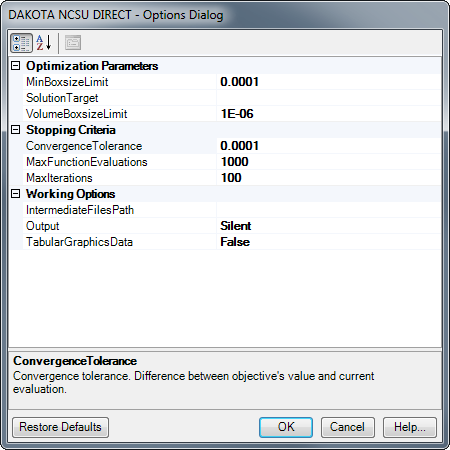DAKOTA NCSU DIRECT
Description
This is an unconstrained optimization algorithm similar to DAKOTA Coliny DIRECT. This is a derivative free optimization method which works by dividing the design space into small rectangular sub-regions. This algorithm tries to balance between local search and global search to identify the best design for a multi-modal objective function.
References
DAKOTA Version 5.0 Reference Manual

Control Parameters
MinBoxsizeLimit: Setting that terminates the optimization when the measure of a hyper-rectangle S with f(c(S)) = fmin is less than MinBoxsizeLimit. The option must have a positive real value.
SolutionTarget: The solution target option specifies a goal toward which the optimizer should track. When SolutionTarget is specified, ConvergenceTolerance specifies a percent error on the optimization. This is used for test problems, when the true global minimum is known.
VolumeBoxsizeLimit: Setting that terminates the optimization when the volume of a hyper-rectangle S with f(c(S)) = fmin is less than VolumeBoxsizeLimit percent of the original hyper-rectangle. Basically, VolumeBoxsizeLimit stops the optimization when the volume of the particular rectangle which has fmin is less than a certain percentage of the whole volume. The option must have a value greater than 0.
ConvergenceTolerance: The convergence tolerance specification provides a real value for controlling the termination of iteration. This control defines the threshold value on relative change in the objective function that indicates convergence. In case of flat functions algorithm may terminate with this criterion rather than the MinBoxSizeLimit. Value must be greater than zero for all cases.
MaxFunctionEvaluations: Function evaluation is the call to Analyzer to evaluate the objective function at the specified points. The maximum number of function evaluations is an integer limit for evaluations that the algorithm can attain. Algorithm can terminate with this criterion if no other criteria are satisfied. A single iteration can contain multiple function evaluations like evaluating neighboring points in the sub-region. MaxFunctionEvaluations must be a positive integer value less than 89,000.
MaxIterations: A single iteration can have multiple function evaluations. This is the integer limit on number of iterations the algorithm can actually run. Option must have a positive integer value.
IntermediateFilesPath: User can specify the location where the intermediate files of optimization should be generated. By default files are written to the user's temporary directory.
Output: This option controls the level of verbosity of messages user can receive from DAKOTA. The options go from Silent to Debug with increasing amount of messages returned from the infrastructure. View Output > Details should show the messages from algorithm. The user can see the objective function values, design variable values, box sizes, number of boxes, etc. for all iterations when Debug is selected for this option. The detailed information can help user analyze the design space and algorithm convergence better.
TabularGraphicsData: Turning this option to true generates a file named dakota_tabular in IntermediateFilesPath directory. This file has the values of design variables, constraints and objective function for each evaluation stored in a tabular format.